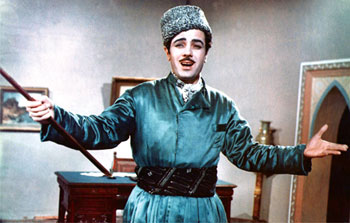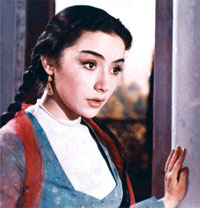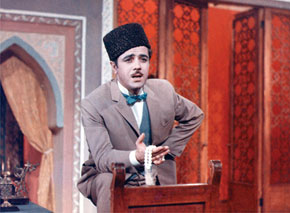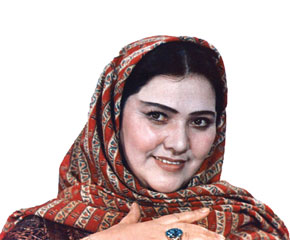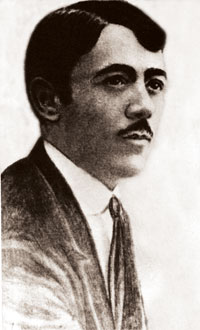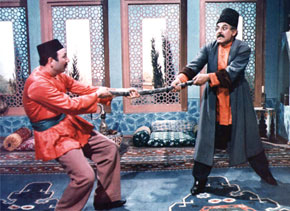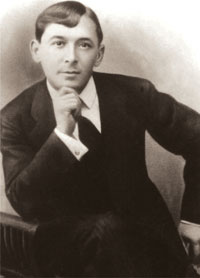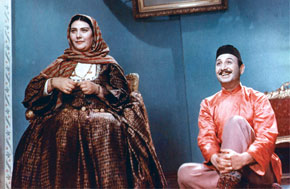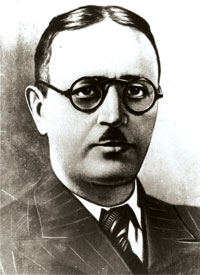Pages 88-97
by Aydin Kazimzadeh
Uzeyir Hajibayov was an outstanding Azerbaijani composer and playwright, the founder of national professional music and national opera and the recipient of the title of People´s Artist of the USSR and of USSR state prizes. Uzeyir Hajibayov received his elementary education in Shusha in Karabakh and went on to study at the seminary in Gori, Georgia. Uzeyir Hajibayov furthered his musical education with courses at the philharmonic society in Moscow and in 1913 studied at the St Petersburg Conservatory.
Uzeyir Hajibayov´s opera Leyli and Majnun was first performed in 1908 in Baku and laid the foundation of the art of opera not only in Azerbaijan but in the Muslim East as a whole. He composed the operas Sheikh Sanan, Rustam and Zohrab, Shah Abbas and Khurshudbanu, Asli and Karam and Koroghlu. The composer was also the first to write musical comedy in Azerbaijan. He made his name as a playwright with the comedies Husband and Wife, O olmasin, bu olsun (Not That One, This One) and Arshin mal alan (The Cloth Pedlar). O olmasin, bu olsun and Arshin mal alan have been translated into many languages and performed worldwide. There have also been several film versions of the comedies both in Azerbaijan and abroad.
by Aydin Kazimzadeh
Uzeyir Hajibayov was an outstanding Azerbaijani composer and playwright, the founder of national professional music and national opera and the recipient of the title of People´s Artist of the USSR and of USSR state prizes. Uzeyir Hajibayov received his elementary education in Shusha in Karabakh and went on to study at the seminary in Gori, Georgia. Uzeyir Hajibayov furthered his musical education with courses at the philharmonic society in Moscow and in 1913 studied at the St Petersburg Conservatory.
Uzeyir Hajibayov´s opera Leyli and Majnun was first performed in 1908 in Baku and laid the foundation of the art of opera not only in Azerbaijan but in the Muslim East as a whole. He composed the operas Sheikh Sanan, Rustam and Zohrab, Shah Abbas and Khurshudbanu, Asli and Karam and Koroghlu. The composer was also the first to write musical comedy in Azerbaijan. He made his name as a playwright with the comedies Husband and Wife, O olmasin, bu olsun (Not That One, This One) and Arshin mal alan (The Cloth Pedlar). O olmasin, bu olsun and Arshin mal alan have been translated into many languages and performed worldwide. There have also been several film versions of the comedies both in Azerbaijan and abroad.
Arshin Mal Alan
Arshin mal alan was first filmed in 1916 by the Filma company. Director Boris Svetlov cast wellknown stage actors Huseyngulu Sarabski as Asgar, Alakbar Huseynzadeh as Soltan bey, Mirza Agha Aliyev as Suleyman and Hanafi Terekulov as Vali. In those days women were not allowed to appear on stage or even in public, so men played female roles. The director cast Ahmad Agdamski as Gulchohra and Yunis Narimanov as Jahan.
The film was first shown on 3 January 1917 at Baku´s Forum Cinema. As a silent film, it was limited in its depiction of an operetta. Uzeyir Hajibayov was not pleased with the quality of the film and stopped its showings. Nevertheless, the film was shown all over the Caucasus and became popular despite the lack of sound.
The second screen version of Arshin mal alan was made in 1945 by the Baku film studio. The film received critical acclaim, winning Soviet and international awards. The music, dramatic tension and design all lent to the film´s success.
The film´s young heroes oppose out-of-date traditions and customs, including arranged marriage at
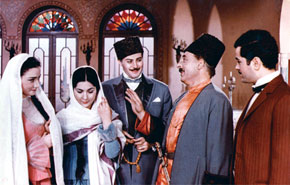 Left to right: Leyla Shikhlinskaya (Gulchohra), Khuraman Hajiyeva (Asya), Murad Yenizarov (Suleyman), Aghadadash Qurbanov (Soltan bay), Hasan Mammadov (Askar), Arshin Mal Alan (1965)
Left to right: Leyla Shikhlinskaya (Gulchohra), Khuraman Hajiyeva (Asya), Murad Yenizarov (Suleyman), Aghadadash Qurbanov (Soltan bay), Hasan Mammadov (Askar), Arshin Mal Alan (1965) The film´s direction (directors Rza Tahmasib and Nikolay Leshchenko) and photography (cameramen Alisattar Atakishiyev, Mukhtar Dadashov) are extremely natural. His performance as Asgar brought singer Rashid Behbudov his early fame. Leyla Badirbayli was a very successful Gulchohra.
The film premiered on 18 September 1945, on Uzeyir Hajibayov´s birthday. Having received positive reviews, Arshin mal alan was shown abroad too. Uzeyir Hajibayov´s fine music and the pithy humour of the people of Azerbaijan earned the film enthusiastic audiences in many countries.
In 1946 the team that made Arshin mal alan was awarded the USSR State Prize and the film was considered part of the Golden Treasure Trove of Azerbaijani cinematography.
The film´s progress from script to release had not been so smooth. In 1941 the Baku film studio received a letter from Moscow saying: “After extremely important and responsible discussions on cinematography held recently in Moscow, the choice of a theme for comedy films was considered an important matter. In this regard, how expedient do you think it is to release a lyrical comedy depicting pre-revolutionary life and ending in the wedding of four couples? The state bodies of Azerbaijan first of all can answer this question …”
This letter, couched in diplomatic language, shows that from 1941 Moscow was against a remake of Arshin mal alan.
When the completed film was taken to the Central Administration of Cinema in Moscow, it was not well received. The film had first been viewed by the arts council and Central Committee in Baku and on 5 July 1945 was reviewed by the arts council, including Sergey Eisenstein, in Moscow. The film was severely criticized and the production team were threatened with deportation to Siberia. One of the directors, Rza Tahmasib, wrote: “Some members of the selection committee received us coldly. When they had viewed the film, they even began to criticize us. They said openly that it was not the right time for Arshin mal alan.”
The discussion included such comments as “Idealization of the lifestyle of khans and bays” and “The photography resembles an advertisement”. But quite a few positive opinions were expressed too.
Directors Mikhail Romm and Nikolay Okhlopkov stated at the meeting: “What was your aim in making this film? Perhaps you wished to say that life before the revolution was as fine as it is on screen?” “Perhaps by making the actors hair shine with brilliantine you wished to incite dealers against the Soviet people?” and so on.
The majority of snide remarks were aimed at the film´s director, Rza Tahmasib. Both the director and film minister Rasul Rza responded to the attacks. One member of the council, an enraged general said, “This film smacks of Siberia,” to which Rasul Rza, replied: “I do not know how to address you, citizen, mister or in another way. But I do know for sure how lucky it is that you are not in charge of cinema.” Director Rza Tahmasib said, “Comrade General, I ask you not to smack us!”
When the meeting broke up Sergey Eisenstein said to Rasul Rza: “I liked your answers today, quiet, ironic. Don´t worry, the film is good. Its simplicity is not a drawback but an asset. The people will like this film; they will grow fond of it.”
After that, the film was discussed at another meeting, this time involving Andrey Zhdanov, secretary of the Central Committee of the All-Union Communist Party. No member of the production team was invited to this meeting. A Moscow filmmaker who attended the meeting told director Mammad Alili that Zhdanov had agreed with the general criticism of Arshin mal alan, but had seen Stalin watching the film with interest (Stalin usually watched all films.) When Zhdanov saw Stalin laughing out loud at the events on screen, he told the leader: “I said to the comrades that it is a good film, an excellent comedy, but they did not change their minds.” According to director Rza Tahmasib, the film was first released in two Moscow cinemas. When the management saw the stream of people flowing to the cinemas, copies were made and distributed to 16 other cinemas. In the ensuing years Arshin mal alan was shown in more than 130 countries under the name Love Beneath the Veil and brought fame to its makers.
It is interesting that in 1946-47 the number of viewers would be counted and the director would receive a percentage fee depending on audience size. However, as numbers became astronomic, the fee was cancelled.
People´s Artist of Azerbaijan Leyla Badirbayli wrote in her memoirs: “The pride of our nation, poet Samad Vurghun told a story about this fine comedy: “After my speech in the House of Lords in London I was very excited. A Moscow representative and I were walking through the streets of London. You won´t believe it but suddenly I saw a big advertising hoarding on which was written, “Arshin mal alan, a film comedy by Uzeyir Hajibayov” and which had a large portrait of you and Rashid. When I went to look at it more closely, my eyes filled with tears of pleasure. Look, I said, Arshin mal alan is being shown in London, and began to laugh out loud.” He often told this story in the theatre and enjoyed it every time.”
A sociological survey held to mark the 100th anniversary of Russian cinema asked respondents to choose their 100 favourite Soviet films that had made a huge impact on the development of Soviet cinema and foreign films shown on Soviet screens. The films were subdivided into three lists, Gold, Silver and Bronze. Cinema experts unanimously put the comedy Arshin mal alan (1945) in the Gold List.
Arshin Mal Alan´s third screen version
Screen sizes were soon extended, technicolour was introduced and the technology of both filming and sound recording developed considerably. Films were shot on high-quality film in both Soviet and foreign production. Given this, the Sovexportfilm association of the USSR Committee of Cinematography commissioned a remake of Arshin mal alan from Azerbaijani film-makers.
The Jafar Jabbarli Azerbaijanfilm studio made the new version of Arshin mal alan to mark the 80th anniversary of Uzeyir Hajibayov´s birth. This time the film was shot in large format and in colour. The film was directed by Tofiq Taghizadeh and the music was adapted by composer Fikrat Amirov. Many scenes were taken from the script and shot in beauty spots in Azerbaijan. Good use was made of the amazing natural landscapes of Goygol and Quba.
Art critic Nazim Sadykhov commented, “The first version of the film (1945) was made exactly according to the play. However the "new" Arshin mal alan film differs from the former in a number of ways. The film is more of a comic opera than an operetta.”
Tofiq Taghizadeh´s direction is not as good as his predecessors´. The actors do not put in such good performances and some of the additional scenes are a distraction.
A year after the film was completed, director Tofiq Taghizadeh and actresses Leyla Shikhlinskaya (Gulchohra) and Safurah Ibrahimova (Telli) were members of a delegation of Soviet film-makers that visited the Middle East, attending Soviet film weeks in Jordan, Iraq and Syria. Tofiq Taghizadeh said that Arshin mal alan had been an instant success everywhere: “In Oman, Baghdad and Damascus, cinema owners persuaded us to extend the programme. We enjoyed hearing the audience sing Asgar´s song after the film was shown in the Al-Huseyn Cinema in Oman.”
Even though the third version of the film was weaker than the second, it was popular with both Azerbaijani and foreign viewers. The film became a fixture in cinema and TV repertoires. All this was thanks to the immortal music and dramatic art of Uzeyir Hajibayov.
Arshin Mal Alan filmed in America
In the early 1940s a group of Azerbaijani art workers saw a film by the name of Arshin mal alan during a visit to Iran. The director of the film was an Armenian. It had been shot in America and did not mention either Uzeyir Hajibayov or Azerbaijan. The unattractive sets and costumes did not fit the film and fragments of music sounded out of tune.
The story on the misappropiation of the operetta Arshin mal alan by Armenians goes back to the early 20th century. In 1915 the operetta Arshin mal alan was translated into Armenian in Tbilisi and performed there. On the eve of the establishment of Soviet power in Georgia a group of Armenian actors and the operetta´s translator emigrated. They took the operetta´s score and libretto with them. They performed the operetta on stage in Istanbul and Athens and then left for the USA.
In 1925 Uzeyir Hajibayov received a letter from the USA from cellist
Send me power of attorney and I will collect your royalties and send them to you…” Uzeyir Hajibayov could not act on this, as according to the rules in place at the time nothing could be done to protect copyright. Soon afterwards a book with the score of Arshin mal alan was published in New York. The book´s cover did not feature Uzeyir Hajibayov´s name at all, just the name of the plagiarist Magalian.
The American film Arshin mal alan was actually shot in 1937 by Armenians, according to information in the Russian State Film Fund that quotes the Catalogue of the American Film Institute. Released on 5 March 1937, the film was directed by Setrag Vartian who also played the role of Asgar. Louise Barsamian played Gulchohra. The alternative name of the film was Love of a Pedlar. The film tells the story of Asgar, the son of a rich Iranian merchant, who has returned from Europe to get married. He contrives to see the girl before the wedding and to marry for love, thus opposing his country´s customs on arranged marriage.
The names of the arias in the film were: I will find a girl for you, Where are you, my darling, Hear my voice and The power of gold.
The programme made for the film named Vartian as the creator and director of this Armenian stage play and one of its performers. The Soviet film made in 1945 was supposedly based on this opera and received the Stalin Prize for a film of fiction.
The film was described as a romantic musical story (an Iranian story). Arshin mal alan was made by Marana Films and is entered in the USA´s cinema encyclopaedia.
